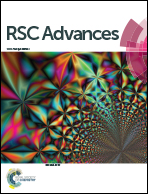Single frequency analysis for clinical immunosensor design†
Abstract
In the current paper, electrochemical impedance spectroscopy has been utilized for the development of an immunosensor with a different approach. The time-dependent phase angle shift technique Single Frequency Analysis, (SFA) depends on monitoring the phase angle change resulting from antibody–antigen interactions. For the purpose of designing an immunosensor an appropriate sensing matrix, namely a graphene oxide (GO)–alginate nanosphere nanocomposite structure (AlgNSp), was prepared mechanically in the presence of epichlorohydrin as the linking agent. This hydrogel based composite structure was synthesized sonochemically, a considerably new method for nanoparticle synthesis, and used as a support for GO to create a more durable film. The morphological structure and particle size were investigated using Transmission Electron Microscopy (TEM) revealing spherical structures with a diameter of 200 nm. Fourier-Transform Infrared Spectroscopy (FTIR) and Energy-Dispersive X-ray Analysis (EDAX) also showed the synthesized nanospheres to have an alginate origin. The optimum frequency value at which the most marked phase angle shift occurs was determined as 100 Hz from the Bode plots. Determination of Tau proteins between a concentration range of 250–0.01 ng mL−1 was executed selectively using the proposed system. A set of studies were carried out using biological samples obtained from patients with various neurodiseases to verify the applicability of the proposed immunosensor in clinical diagnosis. Consistency between the results obtained from the proposed system and commercial ELISA applications revealed the SFA technique to be suitable for the design of sensing systems to be used for clinical diagnosis.



 Please wait while we load your content...
Please wait while we load your content...